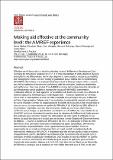Making Aid effective at the Community Level: The AMREF Experience
View/
Publication Date
2011-09Type
Article, Journalviews
downloads
Metadata
Show full item recordCitation
David Ojakaa, Elizabeth Okoth, Sam Wangila, Meshack Ndirangu, Naomi Mwangi & Festus Ilako (2011) Making aid effective at the community level: the AMREF experience, Development in Practice, 21:7, 1013-1022, DOI: 10.1080/09614524.2011.590887
Abstract/
Effective use of donor aid is critical in achieving the sixth Millennium Development Goal –reversing the HIV/AIDS epidemic by 2015. The Paris Declaration of 2005 identified five key principles for aid effectiveness: ownership, alignment, harmonisation, mutual accountability and managing for results. As civil society organisations play a critical role in implementing HIV/AIDS interventions, it is important that they adhere to these principles. Often, however, they fail to implement interventions conforming with the principles, leading to duplication and inefficiency. Two case studies from AMREF in Kenya demonstrate how the principles of aid effectiveness can be applied to increase the impact of HIV/AIDS interventions.
Further Details
Rights & Usage This item is part of a JSTOR Collection. For terms and use, please refer to our Terms and Conditions Development in Practice © 2011 Taylor & Francis, Ltd. Request Permissions
Publisher
Taylor & FrancisCollections
- General - GEN [367]

